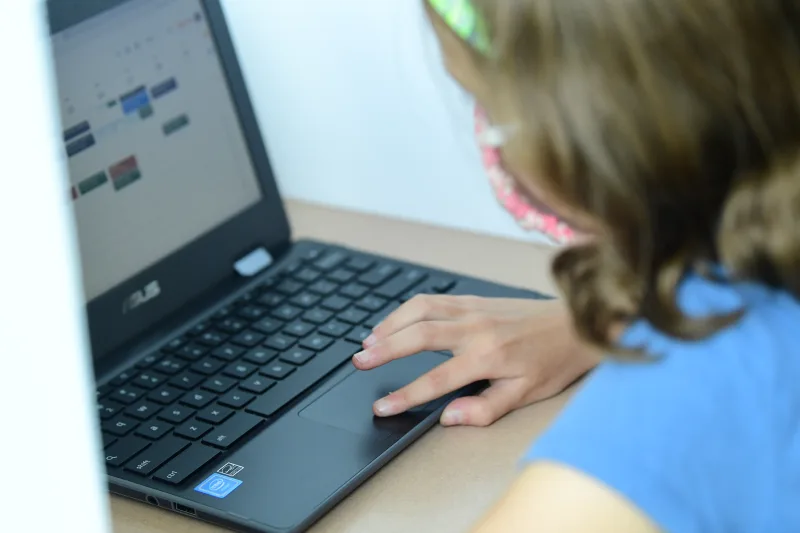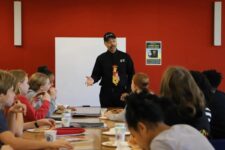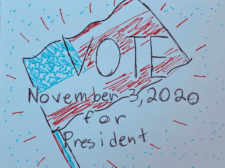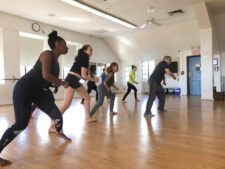It’s lunchtime on a Thursday afternoon in November, and a group of Fieldston Middle students are gathering for their weekly meeting of the Girls in Science club. Courtnay Hull, Fieldston Middle Science Teacher and Department Chair, encourages the students — 6th, 7th, and 8th Graders — to say hello to each other and catch up as more members trickle onto the Google Meet. While some of the students are together on campus, everyone joins the club meeting virtually. The girls are hesitant at first — it’s only their second time meeting as a club — but after a few seconds of silence, one student asks a classic inter-grade icebreaker question to find common ground: “Does anyone take Spanish?” Students nod and begin to compare experiences — classes they’ve each taken over the years. The conversation flows from there.
At Fieldston Middle, clubs provide important gathering spaces for students outside the classroom. Even in the hyflex model, hosting clubs and student activities remains a top priority. Clubs offered at Fieldston Middle are tied to the School’s mission and promote an enthusiasm for learning and artistic expression. They also provide a space where students can forge meaningful friendships as they continue to develop critical social-emotional skills.
“With hyflex and remote learning, there isn’t the same unstructured time to be socializing with each other, which is so much a part of what middle school is,” says Kylah Arias, Fieldston Middle Psychologist. “Clubs give students the opportunity to socialize with students whom they might not know from other parts of their day, with whom they have a shared interest. It’s a unique part of their day.”
“In a middle school environment, it’s important to give kids a space within the school community to connect with other people who are interested in the things they are interested in, academically or not,” says Keira Lapsley, Fieldston Middle History Department Chair and Activities Coordinator.
Lapsley, who oversees Fieldston Middle clubs programming, says that it was never a matter of if clubs would exist this year with the new hyflex schedule, but rather of making sure all the logistics were worked out well in advance so that students and faculty could feel safe and comfortable during a time intended for fun and relaxation. “I wanted to make sure we had lived through a few weeks of the hyflex schedule, through a few rainy days, to make sure we had all the logistics figured out,” she says. “I didn’t want any kids to feel like they couldn’t get an answer to where they needed to be on any given day.”
While some students join each week from campus, all clubs take place over Google Meet. Some clubs therefore needed to translate to a remote setting — and that meant adjusting some programming. Fieldston Middle Arts Teacher Eric Botnick usually leads an art studio club, for example, which was not possible this year. Therefore, he transformed his club into Club Do-Oh, where students form teams and compete in a variety of creative challenges.
Clubs give students the opportunity to socialize with students whom they might not know from other parts of their day, with whom they have a shared interest.
Over the course of their meeting, the Girls in Science club discuss organizing events for later in the year, students share past projects they enjoyed from their science classes, and they talk about current events — one student is excited to discuss the news of an imminent COVID-19 vaccine.
Using a digital bulletin board provided by Hull, the girls share what aspects of science interest them and what kinds of activities they want to do in the club. A few girls request an activity they miss from a typical academic year: hands-on science experiments. Physical distancing restrictions and the hyflex model have made it challenging to incorporate laboratory experiments into the curriculum, so members of the Girls in Science club are hoping they can get their fix of tinkering and testing outside of the classroom. It seems that extracting the DNA from a strawberry may be in the club’s future.

Over on another Google Meet, a few students are discussing the differences between a reported article versus an op-ed (an op-ed is based on one’s opinions, while a reported piece uses only facts, their club advisor, Fieldston Middle English Teacher Sharan Gill, tells them).
The students are selecting articles for the inaugural edition of “The Fieldstonian,” a Fieldston Middle newsletter started by Santo R. ’25. For the December issue, members of the club — which is new this year — will write articles about the election process and results, their thoughts on remote learning and quarantine, and a 2020 year-in-review.
During the club’s meeting, students ask each other for advice about scheduling interviews and crafting arguments for their articles. A few of the 7th Grade students offer to speak with their friends and classmates to find out if they would be interested in being interviewed for any of the articles. By the end of the meeting, everyone is assigned a story and begins to plan the next steps they want to achieve before the club meets again the following week.
Launching a new student-run editorial publication would be ambitious at any time, but given the circumstances surrounding hyflex and remote learning, it’s especially impressive. It also signals the eagerness of Fieldston Middle students to maintain a sense of connection to each other and the School.

One of the challenges of the hyflex model and remote learning has been maintaining a sense of community for students and faculty. “We’ve lost the informal touch points throughout the day — we’re not running into students in the hallways or the cafeteria. We have to be intentional about building ways to connect within the community,” says Lapsley. Clubs are one way for students to connect with each other outside of the classroom, to unwind and bond over shared interests. And students are excited by the opportunity — over 75 students from across 6th, 7th, and 8th Grade signed up to join clubs.
“I feel really encouraged by the fact that we have so many Middle Schoolers who still want to be engaged with other students and teachers during their free time,” says Lapsley. “That’s one of the really cool things about our school community.”



